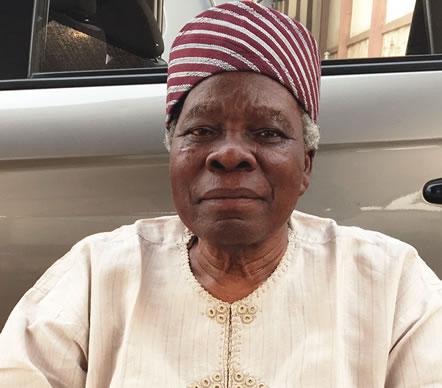Headline
Why I Resigned As Yoruba Nation Leader – Akintoye [Read Detailed Resignation Letters]

The former leader of the apex body of the Yoruba self-determination struggle, Ilana Omo Oodua Worldwide, Prof. Banji Akintoye, has advanced reasons why he stepped down from his position.
The PUNCH reports that the former Yoruba Nation leader handed the baton of leadership to his former Deputy, Prof. Wale Adeniran, citing old age and a weakened body system as his reasons.
But in a letter addressed to Adeniran and sighted by our correspondent on Thursday, Akintoye explained that he did not resign from the position to evade responsibility over the crisis rocking the self-determination group.
READ ALSO: JUST IN: Akintoye Steps Down As Yoruba Nation Leader
Read the full content of Akintoye’s resignation letter below:
“Dear Wale, I write this letter to you in your position as Chairman of Ilana Omo Oduduwa to congratulate you and the newly elected Executive Council of Ilana.
“I also hereby inform Ilana through you of my departure from further responsibilities in Ilana. I urge you and all others not to think that this step is a consequence of recent difficulties in Ilana. As you know better than any other person, I have been seeking for over a year now to take my leave from Ilana because combining the duties of Ilana with the duties of the greatly elevated demands of the Self-determination Struggle has been too heavy for me at my age. I am greatly honored that you as the closest person to me in Ilana, most Ilana members, and all Ilana committees, have for months been urging me not to leave Ilana because, according to you all, Ilana is my special ‘baby’ in the whole Self-determination Struggle. But you would remember that in a special meeting of leaders of the Self-determination struggle from all over the world about a month ago, you and all the other meeting participants agreed graciously that I should give up my duties in Ilana because of my heavy accumulation of duties to the higher levels of the whole struggle.
“As for our current difficulties in Ilana, I am sure you would testify that I am not leaving because of them, and that, in general, even the greatest of difficulties never make me quit. I am imbued with God-given confidence that I can bear all things and solve the most tortuous complications among men, because God in His mercy has given me the gift of a heart that loves all persons in all situations.
“Still, I must ask you to forgive me for leaving Ilana to you in its current condition. I had wanted to leave Ilana immediately after the special meeting of worldwide leaders about a month ago, but I decided to help you to iron out some of the ongoing difficulties before leaving. Unfortunately, things have not improved as quickly as I expected, and you now have to face a situation in which some of our extremists are still compounding the difficulties. However, I have much confidence in you – including confidence that you will find ways to steer our Ilana back to the path of compromise, unity and strength.
“Finally, I must congratulate and thank you for your very high quality of leadership in this struggle for our embattled nation. I must congratulate and thank you, particularly for your bearing with strength and fortitude the frequent vilifications and false accusations. We who have stepped out bravely to liberate our Yoruba nation and to save it from being destroyed by the destructive forces of Nigeria are going through a lot of fire from our own people. No doubt, we shall soon be hearing from some habitual detractors that it was you who disloyally plotted against me and made me to leave Ilana, but we must not let such talk bother us in any way. By the grace of God, we shall win this war and liberate our Yoruba nation, and thereby giving our nation the freedom it desires to develop into a greatly respected modern country in the world.
READ ALSO: INEC Office Fire Attacks: Yoruba Nation Agitators, Politicians Fingered
“Of course, you know that I shall always be available to you – to you personally as a friend and close associate in the higher levels of the Self-determination Struggle, and to Ilana as Patron and Mentor in the way that I am Patron and Mentor to other Self-determination Organizations.
“I thank God for His leadership qualities in you and thank you for giving yourself so unstintingly to our struggle for our nation. Accept my best wishes for you and your family.”
Headline
British Family Accused Of Boarding Dead Grandmother On EasyJet Flight

A British family has been accused of trying to board a dead relative onto an EasyJet flight from Málaga, Spain, to London Gatwick on Thursday, passengers said.
The woman, reportedly 89 years old, was wheeled onto the plane by five family members, who told airline staff she was unwell and had fallen asleep.
Witnesses said the woman was pushed in a wheelchair to the rear of the plane and lifted into her seat. Some claimed they overheard a family member tell a boarding clerk, “It’s OK, she’s just tired,” adding, “It’s OK, we’re doctors.”
READ ALSO:Gunmen Invade Church, Kill Priest’s Wife In Anambra
Just before takeoff, the cabin crew realized the woman had died, and the plane was turned around, delaying the flight by 12 hours.
Petra Boddington, a passenger, said: “easyJet, when did you start letting dead people onto planes? Seriously!” Another, Tracy-Ann Kitching, added: “I saw her being wheeled onto the plane; someone was holding her head as they passed me! A doctor on board confirmed that was already dead when they sat her down.”
EasyJet has denied that a deceased person boarded the plane. The airline said the passenger had a fit-to-fly certificate and was alive when she boarded.
READ ALSO:UK Charges Nigerian-British Art Dealer Ochuko Ojiri With Terrorism-related Offence
“The flight returned to the stand prior to take-off due to a customer on board requiring urgent medical assistance. The flight was met by emergency services, but sadly the customer passed away,” a spokesperson said.
The Guardia Civil in Málaga confirmed officers attended the aircraft, and the woman was declared dead on board. No arrests have been made.
Headline
Russian Strike On Odesa Region Kills Eight, Injures 27

Ukraine’s State Emergency Service has reported at least eight people killed and 27 others injured on Friday night after a Russian ballistic missile strike hit the southern Ukrainian city of Odesa.
According to Ukrainian authorities, the attack targeted port infrastructure facilities in the town of Pivdenne, near Odesa, and damaged nearby civilian vehicles.
The strike came one week after much of Odesa was left without power, heat, and water following a “severe” aerial assault.
“Some of the injured were on a bus that was at the epicenter of the shelling. Trucks caught fire in the parking lot, and cars were also damaged,” the State Emergency Service said.
READ ALSO:Russia Insists Ukraine Must Cede Land Or Face Continued Military Push
Emergency officials said the deaths occurred at a port infrastructure facility. Medical teams and first responders were deployed after the strike, but their work was disrupted by “ongoing air raid alerts,” according to Oleh Kiper, head of Odesa’s regional administration.
Russia has carried out repeated attacks on Odesa in recent days, damaging port facilities, civilian vessels, and key infrastructure.
Two major bridges linking the northern and southern parts of the Odesa region have also been hit, with repairs under way, Kiper said.
Elsewhere, Ukraine’s State Emergency Service reported a “massive” drone attack on the southern Mykolayiv region, which damaged civilian infrastructure and vehicles. No casualties were reported.
READ ALSO:19 Die From Alcohol Poisoning In Russia
Odesa, Ukraine’s largest seaport and a major hub in the Black Sea region, has been a frequent target since the start of the war.
Last week, civilian, energy, and industrial sites in the city suffered extensive damage after what regional officials described as “one of the enemy’s most severe airstrikes,” leaving many areas without power and water.
Russia’s Defence Ministry has not commented on the attack.
Speaking hours before the strike during his annual Direct Line call-in show, Russian President Vladimir Putin said Russia was yet to “see Ukraine’s readiness for peace”.
“[Russia] is ready for negotiations and for ending the conflict via peaceful means,” Putin said, adding that it was up to Russia’s “Western opponents” to end the war.
(CNN)
Headline
Aircraft Crashes In Owerri With Four Persons Onboard

A Cessna 172 aircraft with registration number 5N-ASR, operated by Skypower Express, has crashed at the Sam Mbakwe International Cargo Airport, Owerri, Imo State.
The aircraft had departed Kaduna International Airport en route to Port Harcourt International Airport before diverting to Owerri after the crew declared an emergency.
The crash occurred at about 8:00 pm on the airport premises, with four passengers and crew members onboard.
Confirming the incident, the Director, Public Affairs and Family Assistance of the Nigerian Safety Investigation Bureau (NSIB), Mrs. Bimbo Oladeji, said the agency had been notified of the crash.
READ ALSO:Social Media Feud Spills Into Aircraft As VDM, Mr Jollof Exchange Blows
According to the NSIB, the aircraft crashed on the approach area of Runway 17, but no fatalities have been recorded so far.
The statement said: “Following the occurrence, airport emergency services were successfully activated and arrived on site promptly. Reports indicate that there was no post-crash fire, and the runway remains active for flight operations, with other aircraft taking off safely after the incident.
“Efforts are currently underway to coordinate the recovery and evacuation of the distressed aircraft from the crash site to allow for a detailed wreckage examination.”
The NSIB said it has officially activated its investigation protocols in line with its statutory mandate
READ ALSO:Ogun To Prosecute DJ Over Multiple Road Crashes
The Director-General of NSIB, Capt. Alex Badeh Jr., sympathised with the management of Skypower Express over the incident and expressed relief that no lives were lost.
Badeh Jr. added that the Bureau’s investigation team is already coordinating with relevant authorities to secure the crash site and commence a detailed investigation into the cause of the accident.
Two days ago, 11 persons narrowly escaped death as a private jet crash-landed at Mallam Aminu Kano International Airport, Kano, on Sunday morning.
The occupants, including passengers and cabin crew, were safely evacuated amid an intense atmosphere, eyewitnesses told The Guardian.
READ ALSO:Tanker Crash Kills Three, Fire Razes Shops In Kano
The private jet, owned by Flybird Aviation, crash-landed at about 9:30 a.m. while approaching Kano Airport en route to Abuja.
The incident attracted urgent attention, with emergency staff and other stakeholders converging at the runway to render rescue operations.
The management of the Federal Airports Authority of Nigeria (FAAN) is yet to release an official statement on the incident. Unofficial sources disclosed that the passengers have been taken to an unknown destination.
Several aircraft incidents have occurred at Kano Airport, with several lives lost.
The last incident occurred in May 2002, when an EAS Airline aircraft departed the runway at Aminu Kano International Airport at 1:29 p.m. local time en route to Lagos.

 News3 days ago
News3 days agoFormer Delta North senator Peter Nwaoboshi Dies

 News4 days ago
News4 days agoPolice Confirm Edo Tanker Explosion, say No Casualty

 News4 days ago
News4 days agoGrassroots To Global Podium: Edo Sports Commission Marks Enabulele’s First Year In Office

 Metro3 days ago
Metro3 days agoJUST IN: Former Edo Information Commissioner Is Dead

 News5 days ago
News5 days agoEdo SSG Calls On Media To Support Govt Policies, Assures Better Welfare

 News4 days ago
News4 days agoOtuaro Tasks Media On Objective Reportage

 News4 days ago
News4 days agoOkpebholo Sympathises With Otaru, People of Auchi Over Tragic Tanker Fire Incident

 News4 days ago
News4 days agoIPF Hosts Media Conference, Seeks Protection For N’Delta Environment

 News3 days ago
News3 days agoCoordinator, Edo First Lady Office, Majority Leader, Rights Lawyer, Others Bag 2025 Leadership Award

 News3 days ago
News3 days ago[OPINION] Tinubu: Ade Ori Okin Befits KWAM 1, Not Awujale Crown






























